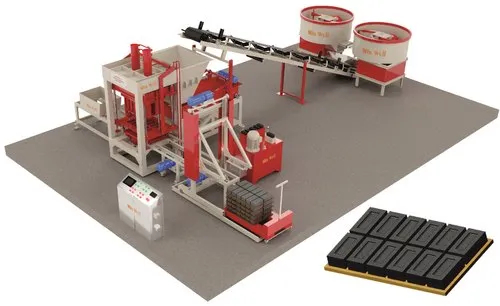
Hydraulic Brick Making Machine
A Hydraulic Brick Making Machine is a mechanical system that uses hydraulic pressure to compress raw materials (like fly ash, cement, sand, lime, etc.) into high-strength bricks and blocks. These machines are known for:
High compression strength
Uniform shape and size
Consistent output
They’re widely used in the construction industry to produce bricks, paver blocks, and interlocking tiles.
| Component | Material | Purpose |
|---|---|---|
| Main Frame | Structural base of the machine | |
| Hydraulic Cylinder(s) | EN8/EN19 Steel | Provides pressing force |
| Hydraulic Power Pack | MS Tank, Pump, Motor | Generates hydraulic pressure |
| Oil Cooler/Filter | Aluminum / Steel | Keeps hydraulic oil clean and cool |
| Press Head | EN9 Hardened Steel | Exerts pressure to form bricks |
| Mould Box & Die Set | Hardened Tool Steel | |
| Feeder Hopper | MS Sheet | Feeds raw material into mould |
| Control Panel | PLC / Relay Logic | Operates cycle, pressure, and timing |
| Vibrator Motor (optional) | 0.5–2 HP | Removes air gaps for density |
CAD Designing – The entire frame and pressure systems are designed digitally.
Fabrication – Machine body, hopper, and hydraulic cylinders are manufactured from steel.
Machining – Precision drilling, boring, and shaping of mould cavities and cylinders.
Assembly – All mechanical, hydraulic, and electrical systems are installed.
Testing – Trial runs are conducted for pressure, mold fitting, and quality of bricks.
Material Filling – The raw mix is poured into the mould cavity.
Hydraulic Compression – Hydraulic cylinder exerts 70–120 tons of pressure.
Dwell Time – The material is held under pressure for a few seconds.
Ejection – The compressed brick is pushed out or auto-ejected.
Cycle Repeat – Typically 8–15 seconds per brick/block.
| Specification | Value |
|---|---|
| Production Capacity | 1,000–10,000 bricks/day |
| Hydraulic Pressure | 100–120 Tons |
| Power Requirement | 7.5–25 HP |
| Operating Mode | Manual / Semi / Automatic |
| Cycle Time | 8–15 seconds |
| Mould Size | Customizable (4”, 6”, 8” blocks, bricks, pavers) |
| Brick Size | Standard: 230x110x75 mm or customized |
Making fly ash bricks
Cement concrete solid bricks
Interlocking pavers
Zigzag and designer tiles (with color mix unit)
Structural Strength – Achieves high-density, crack-resistant bricks.
Fast Output – Each cycle takes only a few seconds.
Eco-Friendly – Uses industrial waste like fly ash, slag, etc.
Cost-Efficient – Reduces dependency on clay and fired bricks.
| Feature | Benefit |
|---|---|
| High Compression | Stronger, uniform bricks |
| Multi-Mould | Multiple shapes/sizes in one machine |
| Quick Cycles | Increases daily production |
| Repeatability | Uniform shape and size across batches |
| Low Maintenance | Sturdy steel structure with fewer moving parts |
| Energy Efficient | Operates on hydraulic system, low power consumption |
| Eco-Friendly | Fly ash usage reduces carbon emissions |
Fly ash brick plants
Infrastructure projects
Government housing schemes (PMAY, etc.)
Private builders and contractors
Urban development missions
A: Fly ash, cement, sand, stone dust, lime, gypsum, and water.
A: Manual machines rely on human effort, while hydraulic machines use pressurized oil for compression—faster and more consistent.
A: Yes. Entry-level hydraulic machines are available for low investment with decent output.
A: 8 to 15 seconds, depending on size, model, and material.
A: No. Periodic oil changes, filter cleaning, and hydraulic inspections are sufficient.
The Hydraulic Brick Making Machine is the backbone of modern, scalable, and sustainable construction material production. With its high compression capacity, flexibility, and low operating cost, it is ideal for any manufacturer looking to produce high-quality, load-bearing bricks or blocks.
Whether you’re producing fly ash bricks, concrete blocks, or interlocking pavers, this machine offers a long-lasting, profitable solution with minimal manpower and maximum efficiency.
Office Address
C-1, 77/1, Kaka Estate, Ambicanagar Road, Nr. National Plastic, Odhav, Ahmedabad – 382415, Gujarat, India.
Factroy Address
24, Shreeji Estate Near Sankalp Estate, Bakrol Cir, Ahmedabad-382430, Gujarat, India
mixwellindia@gmail.com
hardicengineering@gmail.com
+91 99042 01922
+91 98984 74351
Also Send Mail
© Hardic Engineering . All Rights Reserved.
